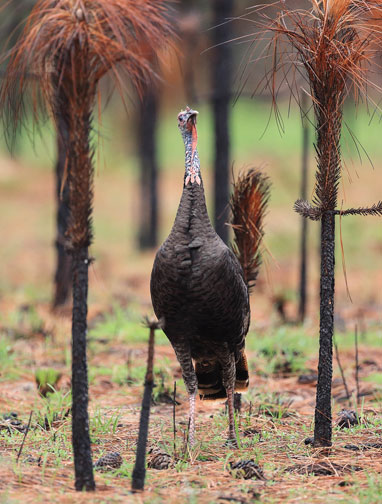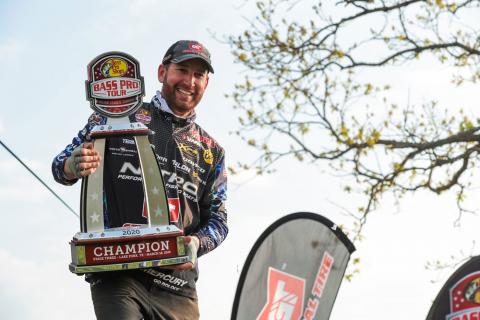provided by John Phillips
Turkey hunters usually follow a progression as they mature and save their money. The first thing they want to do is take turkeys. Next, they try to call up their own turkeys and take them. Then they hunt and take several gobblers where they live. Their next goal often is to go out of state and take a species of turkey they’ve never hunted before. The last great challenge is to take a Grand Slam of all the species of turkeys in the U.S., with the toughest-to-take turkey being the Osceola gobbler, due to his very limited terrain in Florida. Most of the property where he lives is privately held, and the public land that’s available is often crowded. However, Mossy Oak Pro Shane Martinez of Sebring, Florida, is a master of taking Osceolas on public lands. Martinez shares his strategies for finding and taking these elusive gobblers.
 I had hunted this Osceola gobbler on public land all the way through the third week of turkey season one year, and I took off early from my job on a Wednesday - early enough to go home, get my Mossy Oak camo and the rest of my gear and still have about an hour to hunt this bird. This Osceola always would roost in a burned-out bay head swamp that was off the property. He would fly down onto the private land that I had permission to hunt. There was a big canal that divided the two areas he liked to land. One morning he would fly down to one of these places and meet his hens. I always seemed to be on the other side. So, the next morning, I’d go to that side, and inevitably he’d fly down to the other side. This alternating scenario happened for three weeks.
I had hunted this Osceola gobbler on public land all the way through the third week of turkey season one year, and I took off early from my job on a Wednesday - early enough to go home, get my Mossy Oak camo and the rest of my gear and still have about an hour to hunt this bird. This Osceola always would roost in a burned-out bay head swamp that was off the property. He would fly down onto the private land that I had permission to hunt. There was a big canal that divided the two areas he liked to land. One morning he would fly down to one of these places and meet his hens. I always seemed to be on the other side. So, the next morning, I’d go to that side, and inevitably he’d fly down to the other side. This alternating scenario happened for three weeks.
One day I looked on the back side of this canal and spotted a dike that crossed the canal. I decided to get on that dike early in the morning, and then once the tom flew down, crawl on my stomach to get on the same side where he was. Well, when I arrived, the turkey was gobbling his brains out, and I could hear a hen close to him. I finally was able to yelp and get the hen to yelp back to me. Then that hen and I had a calling match, before I finally stopped calling, and the hen stopped. I couldn’t see either the hen or the gobbler and had no idea where they had gone.
After 45 minutes, that tom gobbled, and he was only 60 yards behind me off the property in the thick stuff that turkeys usually don’t fly down to, but this area had been burned. Those turkeys must have felt comfortable, because they could see a little bit better than they could have prior to the burn. Next I saw the Osceola’s fan moving through those burned palmettos. I also noticed that his hen was 5 feet from me. I froze and prayed my Mossy Oak camouflage would keep the hen from seeing me. She popped her wings like she was planning to fly but then started to walk away. I made a light cluck and a super-light yelp, and she walked right past me into a pasture. That ole gobbler couldn’t stand it. He had to follow her. He walked past me at 25 yards, and I took him. He was one of those gobblers that totally could drive you insane.
I’ve taken the Grand Slam of turkeys (the four U.S. subspecies – the Eastern, the Osceola, the Rio Grande and the Merriams), and one day I hope to go to Mexico to get my Royal Slam (the Grand Slam plus the Gould’s turkey that’s found in Mexico and limited areas of the Southwest). To find out more on turkey slams, visit https://www.nwtf.org/hunt/records/slams.
Since I’ve hunted all the different species of turkeys in the U.S., the thing that makes the Osceola gobbler different, especially on public land, is it is the most difficult bird to take of all the different kinds of turkeys in the U.S. The only place you can take a true Osceola is in Florida, and with the inbreeding happening with the Easterns, I think that the boundary is at about Orlando or just north of there. The other thing is that the Osceola will gobble his brains out on the roost, but once he hits the ground, he’ll generally go dead silent - whether they have hens or not. Osceolas change their moods on the drop of a dime. I’ve found that taking Osceola requires much more patience than any of the other species. I’ve taken as many Osceolas and probably more that have come in silent than I have those that have come in making noise.
If I’m out running and gunning and haven’t located a turkey, I’ll use a box call that will cut through the wind and penetrate thick terrain to try and make a turkey gobble, as well as crow and hawk calls. Previously, I’ve even used an air horn to make them shock gobble. If those turkeys aren’t gobbling very much, I may only call to them every 15 or 20 minutes. If I don’t see a turkey after another 15 or 20 minutes, I make sure he can’t see me. I may move my calling location just to simulate a hen that’s walking off. Then I’ll call a little more. Once I know a gobbler is getting close, I’ll either give him the silent treatment, or I’ll cluck and purr very softly. I even may just scratch the leaves with my hands.
The Osceola gobblers generally aren’t as big as the other breeds of wild turkeys. They average 16-18 pounds and can get up to 20 pounds. The ole turkey I talked about at the first of this day was a monster. He weighed 19 pounds, had a 10-3/4” beard and 1-3/8” spurs. Last spring I took a young fellow hunting with me, and he killed a 20-pound Osceola with an 11-inch beard and 1- 9/16” spurs. That was bigger than any Osceola turkey I’ve killed.
For more information about hunting Osceolas in Florida, visit: https://myfwc.com/hunting/turkey/get-started/safe-hunt/ and https://myfwc.com/hunting/turkey/.



























